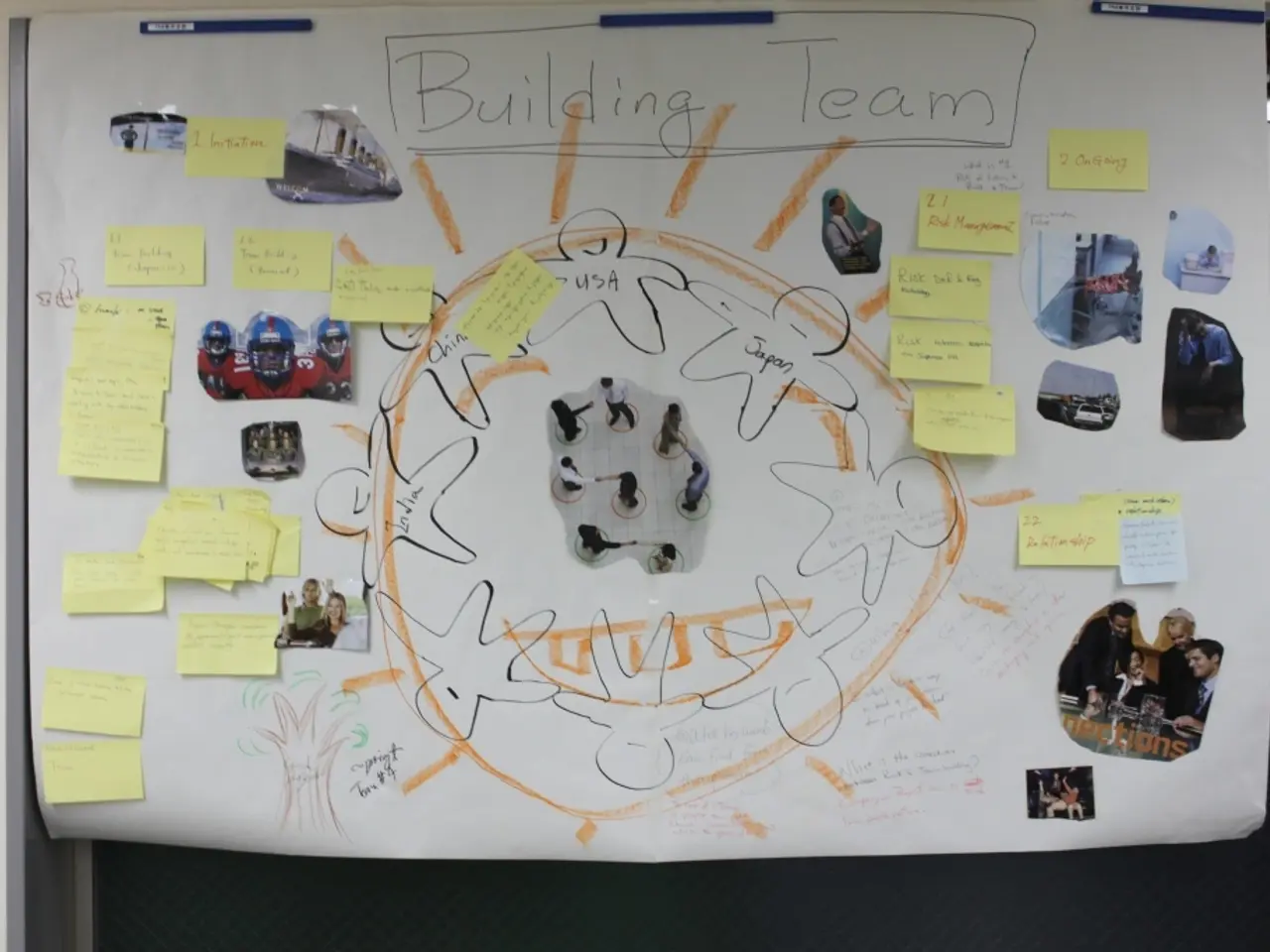Coordinating Influencer Performance Metrics with Objectives and Key Results: A Comprehensive Tutorial
In the ever-evolving landscape of digital marketing, influencer marketing has become a crucial tool for brands seeking to engage with their audience in a more authentic and personalized manner. However, to ensure that this strategy aligns with corporate objectives, it is essential to measure and optimize influencer marketing Key Performance Indicators (KPIs) effectively.
Building an Alignment Stack
To catch drift early, a three-tier "Alignment Stack" is proposed. Gate KPIs, such as Brand-Fit Score and Safety Screen Pass Rate, must be green before any spend is approved. Flow KPIs, including Contract SLA, UTM implementation rate, and Asset Delivery On-Time %, are tracked weekly. Impact KPIs, such as Cost per Qualified Click and Retained Followers %, are reviewed at Key Result (KR) checkpoints.
Establishing a Repeatable Mapping System
A repeatable mapping system is proposed, consisting of KPI → KR → OKR, wired through briefs, contracts, tracking plans, and dashboards. This system ensures that every deliverable can be traced back to a quarterly result and that dashboards trigger actions before misalignment starts screaming.
Focusing on Operational Levers
Operational levers play a significant role in maintaining alignment. For instance, inserting a mandatory "values clause" in briefs and tagging potential risk topics in Sprout/Radian6 to auto-flag comments for moderation can help keep the path unobstructed.
Defining Clear Objectives
To measure and optimize influencer marketing KPIs for alignment with corporate objectives, start by defining clear, revenue-connected goals that link directly to your business outcomes. Examples include brand awareness, engagement, content creation, or conversions, ensuring these goals align with the marketing funnel stages relevant to your corporate strategy.
Selecting Relevant KPIs
Use a combination of content performance metrics, audience engagement metrics, influencer-specific KPIs, and sales/conversion metrics to capture both reach and action. These KPIs help evaluate influencer fit and efficiency and directly measure ROI and link to revenue goals.
Mapping the Customer Journey and Data Touchpoints
Align influencer KPIs across the funnel stages—from awareness to conversion—to measure impact at each step and optimize accordingly. This approach ensures that the influencer's impact is tracked throughout the customer journey.
Integrating Influencer Data with Broader Marketing Analytics
Combining influencer analytics with overall marketing and revenue operations data provides a holistic performance evaluation and seamless optimization.
Analyzing and Optimizing Continuously
Regularly track campaign performance, adjusting influencer selection and content strategy based on metrics like engagement rates, audience overlap, and content resonance. Optimize cost efficiency via cost per engagement and exclusivity assessments to balance investment and impact. Leverage audience demographics and sentiment analysis to refine targeting and messaging.
In summary, effective measurement and optimization of influencer marketing KPIs require tying influencer metrics to clearly defined corporate goals, selecting precise KPIs measuring content quality, audience engagement, and revenue impact, mapping these to the customer journey, and integrating data for continuous campaign refinement.
By focusing on fitness and follow-through, analyzing brand-creator collaborations, and re-engineering the measurement layer when necessary, brands can ensure that their influencer marketing efforts align with their corporate objectives and deliver tangible results.
- In the realm of finance, responsible gambling initiatives prioritize the well-being of consumers, ensuring they maintain control over their spending.
- Personal-growth books often cover topics such as wealth management, offering insights and strategies for financial success and personal fulfillment.
- When it comes to entertainment, casino-games like poker and blackjack have gained popularity due to their combination of skill, luck, and excitement.
- In the world of technology, data-and-cloud-computing advancements facilitate the development of sophisticated gambling algorithms and systems.
- Travel destinations such as Las Vegas are renowned not only for their casinos and entertainment offerings but also for their luxurious fashion-and-beauty, food-and-drink, and home-and-garden experiences.
- Career-development in the casino-and-gambling sector can lead to positions like casino-personalities, influencing the growth and trends of the industry.
- Social-media platforms have become essential tools for casino-culture enthusiasts, connecting them with like-minded individuals through discussions on gambling trends and big-wins.
- Books on pop-culture often delve into the history of casinos, exploring their role in movies, TV shows, and celebrity scandals.
- Education-and-self-development courses in responsible-gambling provide skills training for individuals seeking to understand and manage their gambling habits responsibly.
- In today's political climate, debates surrounding casino-and-gambling regulations frequently arise, with proponents arguing for economic benefits and critics raising concerns about addiction and community impact.
- Job-search websites cater to individuals seeking career opportunities within the casino industry, ranging from frontline operations to high-level management positions.
- Influencer personalities in the fashion-and-beauty space often collaborate with brands, helping to drive sales and long-term customer engagement.
- With the rise of e-commerce, shopping platforms have emerged as a significant aspect of the fashion-and-beauty and lifestyle industries, making it easier for consumers to access trends and find their perfect products.
- Passion for cars can manifest into careers in automotive journalism, reviewing media, and even the development of electric or self-driving vehicles.
- Science-fiction and fantasy fiction often incorporate themes of wealth, power, and intrigue, reflecting the allure of the casino-and-gambling world.
- In general-news outlets, coverage of accidents and crime rates in gambling destinations provoke discussions on public safety, community impact, and corporate responsibility.
- Learning testimonials from influencers can inspire others to pursue their passions in fields like education, home-improvement, and sports coaching.
- In the sports sector, athletes often endorse brands in the fashion-and-beauty, food-and-drink, and footwear categories, influencing consumer decisions and preferences.
- Books on memoirs and biographies frequently chronicle the lives of influential figures in the casino-and-gambling industry, providing insights into their successes and failures.
- As relationships form within industries like finance and technology, networking events and conferences foster collaboration, ideas, and career development opportunities.
- Travel bloggers often share their experiences visiting casinos and gambling destinations, offering recommendations on activities, dining, and accommodations.
- Successful investments in financial markets or real estate can lead to significant big-wins, providing individuals and entities with wealth to pursue passions such as fashion, cars, and luxury travel.
- Investing in casino-and-gambling stocks can offer opportunities for lucrative returns, particularly in regions with favorable regulations and expanding markets.
- In the realm of sports betting, statistics and strategies help sports enthusiasts make informed decisions, minimizing risk and maximizing potential winnings.
- Entertainment portals that focus on movies, TV shows, and game reviews often cover aspects of technology, providing insights into the latest developments impacting the gaming and gambling industries.




